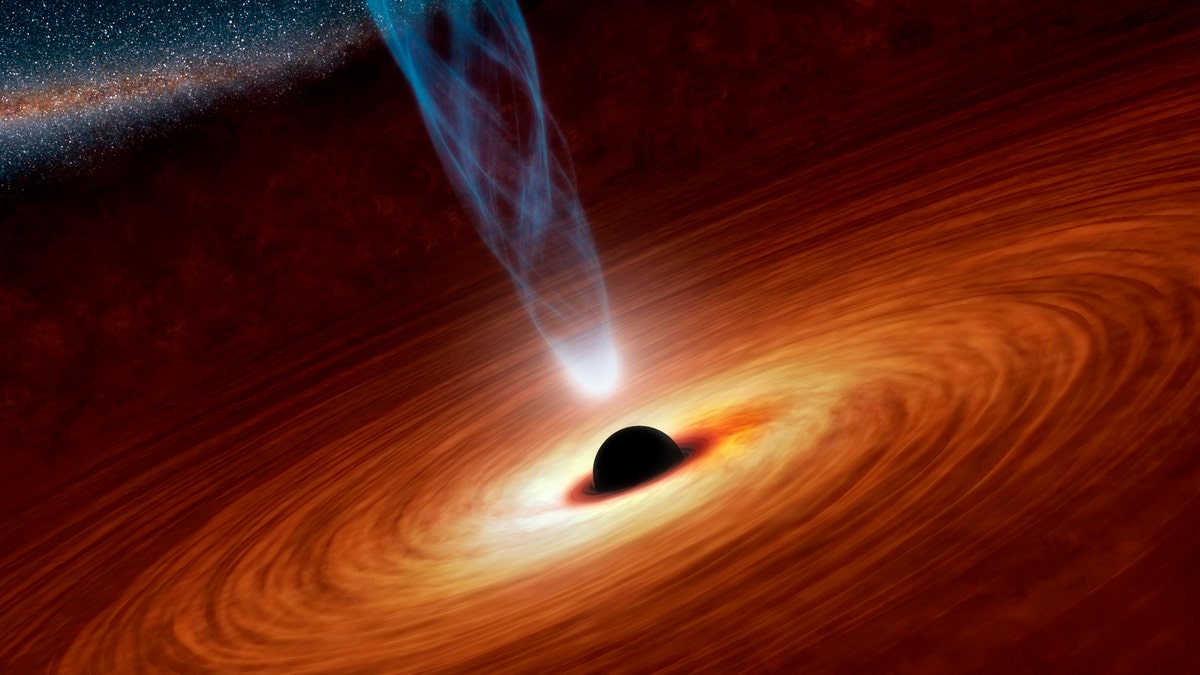
An artist's illustration shows a supermassive black hole. (REUTERS/NASA/JPL-Caltech/Handout)
When most people think of supermassive black holes, they think of large, destructive forces sucking up anything unlucky enough to get in its field of gravity. However, researchers are now discovering that they may have a hand in a galaxy’s formation as well.
“Theoretical understanding is that black holes have a huge influence in making galaxies the way we see them around us,” Chris Harrison, from The Centre for Extragalactic Astronomy at Durham University in the U.K., told FoxNews.com. “Previous observations that have seen this occurring have been on galaxies that are exceptionally bright when viewed through radio telescopes - hence they are rare. We wanted to see what happens in more ordinary galaxies to tell us if this process is universal.”
Using the National Science Foundation’s Very Large Array (VLA), Harrison and his team discovered surprisingly energetic activity in what had been previously deemed a “boring” galaxy. This discovery, in what is called the Teacup Galaxy, due to its appearance, has given astronomers a rare insight into a supermassive black hole’s influence on a galaxy. “Our work has been showing that black holes are very capable of causing havoc over very large distances,” Harrison told FoxNews.com. “Amazingly, even though the black holes are around the billionth the size of the galaxies that they live in, they are still capable of injecting massive amounts of energy across the whole galaxy. This energy leads to gas being heated and driven out at incredible speeds.”
Two of the major types of galaxies are spirals and ellipticals. Spirals are very gaseous and have actively forming stars, while ellipticals are characterized by far less gas and star formation. Astronomers believe that massive ellipticals began as star-forming galaxies, with supermassive black holes emitting powerful jets that can remove or eliminate raw matter needed for further star formation. With a distance from Earth of 1.1 billion light years, the Teacup looks to be an elliptical galaxy going through its transformation stage from a star-forming galaxy. “This particular piece of work on the Teacup Galaxy has provided new insight into how the black holes [drive energy] in ordinary galaxies,” Harrison said. “They appear to be capable of driving jets of charged particles that collide into the gas. You could imagine the ‘jet’ as like a water cannon being driven into a crowd of people - the water cannon collides with the crowd and causes it to break up and disperse rapidly. In this analogy, the crowd represents the gas in the galaxy that is trying to form stars, but is destroyed by the jet.” In other words, the black hole is creating one giant storm in the middle of the galaxy. The VLA radio telescope revealed that the galaxy has “Radio bubbles” reaching 30,000 to 40,000 light years on all sides of its core, as well as smaller “jet” structures 2,000 light years in size. Observations reveal that the jets are accelerating the gas at speeds up to 621 miles per second.
This begs the question - did a supermassive black hole have a hand in the creation of our galaxy? According to Harrison, it’s possible. “There is a supermassive black hole at the center of our Milky Way,” he said. “There is now good evidence that this black hole has driven large amounts of energy into the galaxy in the past, through the so-called ‘Fermi Bubbles,’ as well as other evidence. It is likely that billions of years ago the Milky Way was forming stars much more rapidly and the black hole may have played a role in shutting this down. However, this is not well understood. It is worth pointing out that the galaxies where we believe supermassive black holes have had the most influence are ‘dead’ with little-to-no stars forming. In contrast, the Milky Way is still forming stars (around one per year).”
Harrison also notes that the Teacup galaxy is only the first “radio quiet” (not very bright when viewed through radio telescope) galaxy the team examined through the VLA, and that they are currently working on looking at many more.
